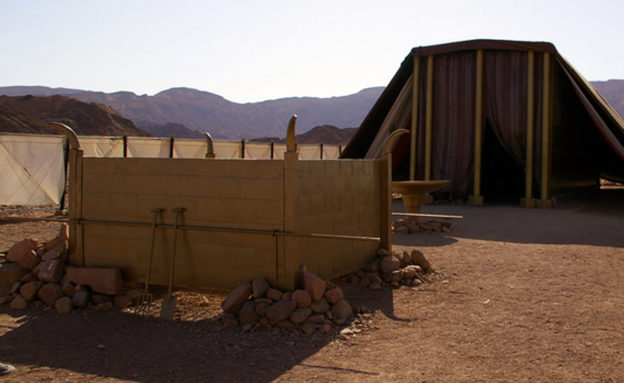Watching television shows like The Crown, it is hard not to be caught by the grand entrances that royalty and nobility have to their palaces and households. Brick or crushed stone driveways from a front gate, leading into a courtyard area with some sort of fountain or sculpture. It screams MONEY and lets you know you are not approaching my more humble estate, with its stately concrete drive and a letterbox.
The area surrounding God’s tabernacle, his palace amongst his people, also made clear that you were not entering any ordinary household. The expansive, walled off courtyard surrounding the tabernacle, reminded God’s people they were coming closer to the special presence of God. The altar reminded them of the means of access – God’s forgiveness. As we enter God’s presence, we too must remember that our privileged access is through the same.
The first item which God instructs Moses to construct for outside the tabernacle itself is the altar. As with many of the other items described, this was to be made of acacia wood (v.1). It was approximately 2.25 metres square by 1.35 metres high (v.1).
The altar had horns on the four corners, possibly symbolic of strength and power (v.2). Horns were associated with such in these days, and we see horns used figuratively to describe strength and power (eg, Daniel 7).
The altar was overlaid with bronze, as were the utensils needed (vv.2-3). A bronze grill on which the sacrificial meat cooked was also needed (v.4). As with other equipment, poles and rings were used to transport the altar, though this time, made or overlaid with bronze (vv.5-8)
Note that in previous chapters, the tabernacle’s contents were gold while the feet that the tabernacle poles rested on were silver. Outside the tabernacle, bronze is used.
While more practical from a heat perspective – bronze is more resistant to melting than gold, there is also symbolic significance in the use of precious metals. Those closest to God, to a symbolic heaven on earth, are gold. That which touched the earth in the tabernacle (the feet of the poles) are silver; the altar, outside the tabernacle, is bronze.
The altar sat inside a courtyard which was created by a fabric fence, made of fine linen held up by poles overlaid with bronze (v.9ff). The hooks for the fabric were silver (v.10). Even though this was a fence, it was still a high quality (if portable) one. The courtyard created by the fabric was about 45 metres long by 23 metres wide, a substantial size.
The courtyard needed a gated entrance, and the design accommodated this need. A nine metre wide gate with a screen allowed access into the courtyard, from the east side (v.16). While there may be symbolic importance in this width, it would also be pragmatic as bringing sacrificial animals, let alone all the people coming with those animals, into the courtyard would need a wide entrance!
The effect of this courtyard was to draw attention to two items within it: the altar, and the Tabernacle. The Israelites entering the courtyard were left in no illusions as to whose grounds they had entered. They were entering into the grounds of the Great King, the earthly home of the thrice holy God who had saved them for himself. This access was graciously given to them rather than any other people on earth.
They would also have recognised the limitations in how far they could enter. Any Israelite (and any Gentile willing to become part of God’s covenant community by faith) could enter into the courtyard area, but no further. The priests, who offered their sacrifices for them, could enter into the outer room of the tent, but no further. Only the High Priest, once a year, could enter the inner room (Most Holy Place) of the tent. The closer to God, the more ceremonially cleansed and holy you had to be.
Presented with that reminder of their sinfulness, the altar would have spoken volumes too. Through various sacrifices offered there (see Leviticus) the Israelites acknowledged their sinfulness, received forgiveness from God, and gave thanks to him for his saving deeds, past and present. Without that altar, burning the offerings which God accepted as tokens of sacrifice for their sin, they could not remain part of God’s People or enter into the grounds of his presence with them.
While we do not have a physical tabernacle with a physical altar and courtyard, the same is true for us. Our access into God’s presence is secured through the once for all perfect sacrifice of Jesus for our sins (Hebrews 9:11-14). The altar of bronze no longer burns, because Jesus’ blood has satisfied God’s anger at our sin. This sacrifice gives us the confidence to enter the holy places previously barred to most of us (Hebrews 10:19-22), to enjoy God’s presence.
Through Christ, we can join the psalmist in enjoying that privilege of presence in God’s courts, not just for one day but for thousands more still to come.

